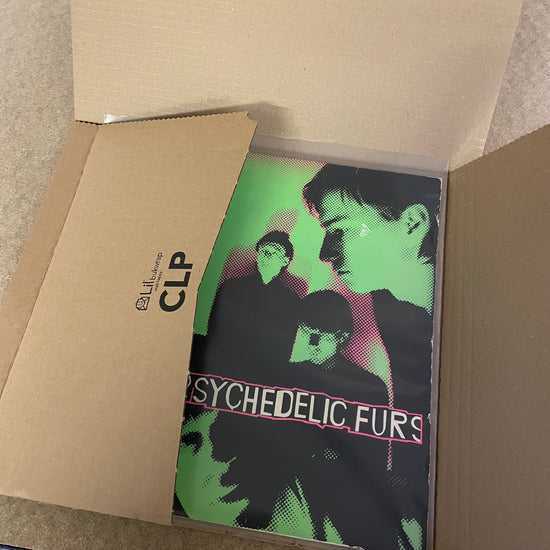Followed by proper storage and maintenance, a record should only need to be thoroughly cleaned once. Keep reading to learn exactly how to clean your vinyl at home, using soft, lint-free microfibre cloths and a high-quality alcohol-based record cleaning fluid.
Whether you’re just starting your record-collecting journey or already have lots of experience, we know that your records are your pride and joy and you'll want to keep them looking as good as they can for as long as they can. Here are our tips for keeping your collection clean.
This article includes product recommendations. Our recommendations are genuine and for products we have decided to use ourselves after years of experience with records. As we are in the UK, we buy from other UK companies where possible. The businesses we've found are just as passionate about what they do as we are and produce high-quality products that we use every day.
Introduction
Records will decay over time if cared for incorrectly even if they aren’t played frequently, so caring for and correctly storing your records is paramount for making the most out of your collection. Below, we'll take you through the easiest way to get your records looking and sounding better than ever, without using an expensive or bulky machine to clean.
It’s a good idea to give your records a light clean before and after every single listen, to ensure that no dust or debris has collected on the record during storage or after being played. We would recommend using either an anti-static carbon fibre brush or a velvet anti-static brush to gently clean the playing surface of the record, not applying too much force, as this could push the dust or debris into the grooves of the record and could cause damage.
When To Do A Deep Clean?
If you’ve purchased a second-hand record, or if it hasn’t been played for an extended period, giving the record a deeper clean is probably a good idea. However, records purchased from Atlas Records shouldn't require a clean!
What Will I Need?
- A clean workspace
- A bright light
- Microfibre cloths
- Vinyl cleaning solution
- Small spray bottle
- Distilled water (optional)
- New inner sleeves (optional)
- New outer sleeves (optional)
1. Prepare Your Workspace
Before we start, we want to ensure that the environment we’re going to clean in, is clean itself. This means clearing a workspace and wiping it down with a cloth and preferably an anti-bacterial surface cleanser to prepare to clean. You also want to ensure that the area you are cleaning is well-lit, with a dedicated light source on or near the workspace.
Did You Know?
You shouldn't store your records in PVC sleeves - these release a gas which will damage your records and sleeves over time.
2. Use A Bright Light
You may want to invest in a bright desk light to help show imperfections on the play surface. We look at every record several times under a light when putting them through our inspecting, cleaning, and grading process. It is remarkable how much more you can see when exposed to bright light. This process is essential if you want to give the record a grade, but it can also be beneficial for showing any damage that might cause damage to the record or even the turntable during playback.
3. Cleaning The Record
Now our area is clean we want to lay down a microfibre cloth (we would recommend microfibre cloths from Paragon) and place the record flat on top of it. Apply a small amount of vinyl cleaning solution (we get ours from Barry at vinylshelter.co.uk) using a small spray bottle to the playing surface and then take another microfibre cloth and gently rub the cleaning solution around the grooves of the record, making sure to do large circle motions following the grooves of the record and adding more solution if needed.
Which Microfibre Cloth Is Best?
When it comes to microfibre cloths, you want to ensure that you are buying very high quality. Anything that touches the playing surface of a record must be extremely soft and lint free. Paragon sell seamless cloths, which are that bit more expensive than regular edge seamed cloths, but will prevent the risk of the edges touching and causing damage to your records.
Make sure to wash and tumble dry the cloths before you first use them, as they tend to have some lint on them when brand new. Please see Paragon's website for further cleaning and care advice.

How Careful Do I Need To Be With The Record?
Try not to clean across the grooves as this can cause dirt and debris to be pushed into the grooves and potentially damage them. Once you’ve done this and are happy that your record is looking clean, flip the record and repeat on the other side. It’s a good idea to try and remove any excess cleaning solution from the record with a dry part of the cloth (or another cloth) before going to play it or returning it to storage.
Handled correctly, records are surprisingly hard-wearing, so you can press reasonably hard on the surface using the cloth, as long as you follow the direction of the grooves.
Aren't Alcohol Based Fluids Bad For Records?
Alcohol-based fluids with a higher alcohol content do have the potential to cause damage to records, with some saying that the alcohol can 'dry out' the plastic and strip away the top layer. The fluid we buy from Vinyl Shelter has been developed in consideration of these risks and has a lower alcohol content. It also doesn't need to be diluted, kills static on new records and is residue-free.
While alcohol based cleaning solution is great, it is not advisable for more delicate records such as picture or flexi discs. The alcohol in the solution can cause damage to the very thin layer of plastic that holds the grooves on these records, so we recommend using distilled water to clean these.


4. Cleaning The Record Sleeve
We also want to ensure that our record sleeves are well looked after, so it is a good idea to clean them too, especially as you are probably storing the records inside or next to them. The process is similar to that of the record, however, for the sleeve we suggest being more careful about using the alcohol-based cleaner, as alcohol in it could cause the printing ink to run. Some sleeves definitely shouldn't be made wet - like the inner sleeve from Led Zeppelin's 'In Through The Out Door' that changes colour when wet! You should also be careful when cleaning any more porous or unlaminated sleeves.
Instead of the alcohol-based cleaner, we find that distilled water on sleeves is usually sufficient. Make sure you allow the sleeve to fully dry before putting it back in storage - especially inside a gatefold - as the excess water on the sleeve could cause mould over time.


5. Add New Protective Sleeves
Now that both the record and its sleeve are looking as good as new, we would recommend them in a way that will keep them in their best condition possible. We would recommend storing the record in an anti-static inner sleeve, like our archival rice paper inner sleeves. Then, place that inside or next to the record sleeve, and store all of it inside an outer sleeve made from Polythene or BOPP polypropylene. You can buy the softer polythene sleeves from us or resealable ones from Spincare.
The Dangers of PVC Sleeves
Do not store your records in firmer PVC sleeves - these release a gas which will damage your records and sleeves over time. We have taken on collections that have sat in PVC sleeves for decades and in the worst cases have been unable to unstick the PVC sleeves from the record sleeve! Many picture discs will have originally been sold in a PVC sleeve - we recommend removing it and storing it in something else.
6. Return Records To Storage
Your cleaned records can go back to where you store them, making sure to store them standing vertically and not horizontally, to prevent them from warping under the weight of each other. It's also important to avoid overcrowding the area that they are stored in so that they aren’t squashed and pulled around every time you go to play one of them.
If you've bought from us before, you'll know that every record we sell comes with a brand-new anti-static inner sleeve and a resealable outer sleeve. We've also cleaned both the sleeve and record, so the record will reach you turntable and storage ready.










1 comment
Is distilled water better then alcohol to clean records